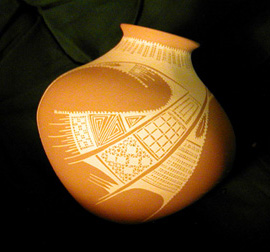This post we invite you to test your knowledge of the
information thus far. Knowing different ceramic usages and certain significance
or symbols to Mesoamerican cultures, can you guess what each of these ceramics
were used for? What would you say is the significance of shape or style of the
vessels, and what was most likely its purpose? As you scroll through the next
few objects, take time to question and really observe elements of the vessels
before continuing to scroll down to its caption and meaning below. Good luck!!
 |
| Source: Division of Anthropology, American Museum of Natural History by Denis Finnin |
Firstly notable
is the tripod shape. This vessel was used by nobility for drinking chocolate at
feasts and ceremonies. Chocolate, the drink of elites, was typically drank at
ceremonies. This Zapotec piece features the God of Dance and Music.
 |
| Source- Metropolitan Museum of Art |
This piece can be
observed as another tripod vessel. This can be associated with Aztec’s, as the
headpiece is similar to Aztec deities seen in other motifs. Animals were
typically associated with gods, such as birds were associated with celestial or
ancestor relations. ¹
 |
| Source- De Young, Fine Arts Museum of San Francisco |
A mosaic handle decorates this knife, and this piece has a lot to take in. One
observes the dark chipped away blade, leading to the notion that the blade is
of obsidian. It is, and the mosaic tiles (shells and turquoise) that form the handle are held in from
anything from wood, ceramics, or resin. This particular one is of resin, with a
designed animal mosaic and shape. Possible a bird? It was most likely used in
ceremonies and rituals due to its craftsmanship and animal handle. This piece is Mixtec (Aztec).
 |
| Source- De Young, Fine Arts Museum of San Francisco |
This oddly shaped
lidded bowl is meant to be a turtle shape. It is Mayan. Mayans believed the
turtle to be a symbol of fertility and growth, due to Mayan myths that the
world was created from a turtle shell. This dish and others are usually found
in tombs and were used as means of offering food to the gods and ancestors
during ceremonies.²
 |
| Source- Staaltliche Museen zu Berlin, Ethnologisches Museum by Ines Seibt |
Here we have
another ceramic used in ceremonies and feast. This goblet features serpents
painted. It is Cholula-style.³ Such fine goblets were used by elites and
rulers, or commonly created as gifts to be given to those visiting. They could
take these pieces home with them thus allowing the showing of wealth and power
to those visitors homelands.
 |
| Source- Metropolitan Museum of Art |
|
This tripod vessel is known as a ceramic brazier. Due to its similar religious architecture of the Aztec at Tenochtitlan, one can assume it was used in religious ceremonies.¹ It was used to make offerings to the Gods, whether that be human or animal remains, or incense or food. The motif on the front is unknown of meaning, though some suggest it is a date, which would correspond with the new temple building at Tenochtitlan.
 |
| Source- Metropolitan Museum of Art |
|
Another noticeable bird, specifically a vulture, this piece is a bit different from the other ceramics. We thought we would make the last one more interesting. This piece comes from the Isla de Sacrificios (Island of Sacrifices), which was found by the Spanish in a conquest and named due to the findings of heart sacrifice victims. The piece fits in with other pieces of ceremony and sacrifice by its brown, red or white bands found on a plain and uncolored background.
So that is the choices we chose to reflect on. How did you do? Were you able to analyze the piece and form guesses based off of those observations? Were you able to guess usages and symbolism of shapes? We hope so!! This concludes this weeks visual walk through of different ceremony and ritual ceramics.
¹Metropolitan
Museum of Art
²de Young
Museum of Fine Arts
³The
National Endowment for the Humanities










